The Significance of Secure Attachment in Human Lifespan Development
VerifiedAdded on 2021/06/17
|9
|2311
|88
Essay
AI Summary
This essay explores the crucial role of secure attachment in human lifespan development, drawing upon the work of John Bowlby and attachment theory. It examines the impact of early caregiver-infant relationships on emotional, social, and cognitive development, highlighting the differences between secure and insecure attachment styles. The essay discusses the long-term effects of secure attachment, including improved social skills, academic performance, and the ability to form healthy relationships in adulthood. It also addresses the application of attachment theory to adult romantic relationships, emphasizing the influence of early experiences on adult attachment styles and behaviors. The essay concludes by underscoring the significance of creating secure bonds between caregivers and children for fostering positive developmental trajectories and overall well-being throughout life. The essay emphasizes the environment provided to the infant has a tremendous impact on all aspects of a child early development and as well as later life. This is the infant experience that develops from the early caregiver relationship. The type of attachment is determined by the type of relationships. Healthy and secure attachment leads to positive impacts on the life of an infant. These effects have long-term effects on child’s developmental results. However, negativity, rejections, emotionally insensitive and carelessness in caregiving impact negatively on the child’s attachment development.
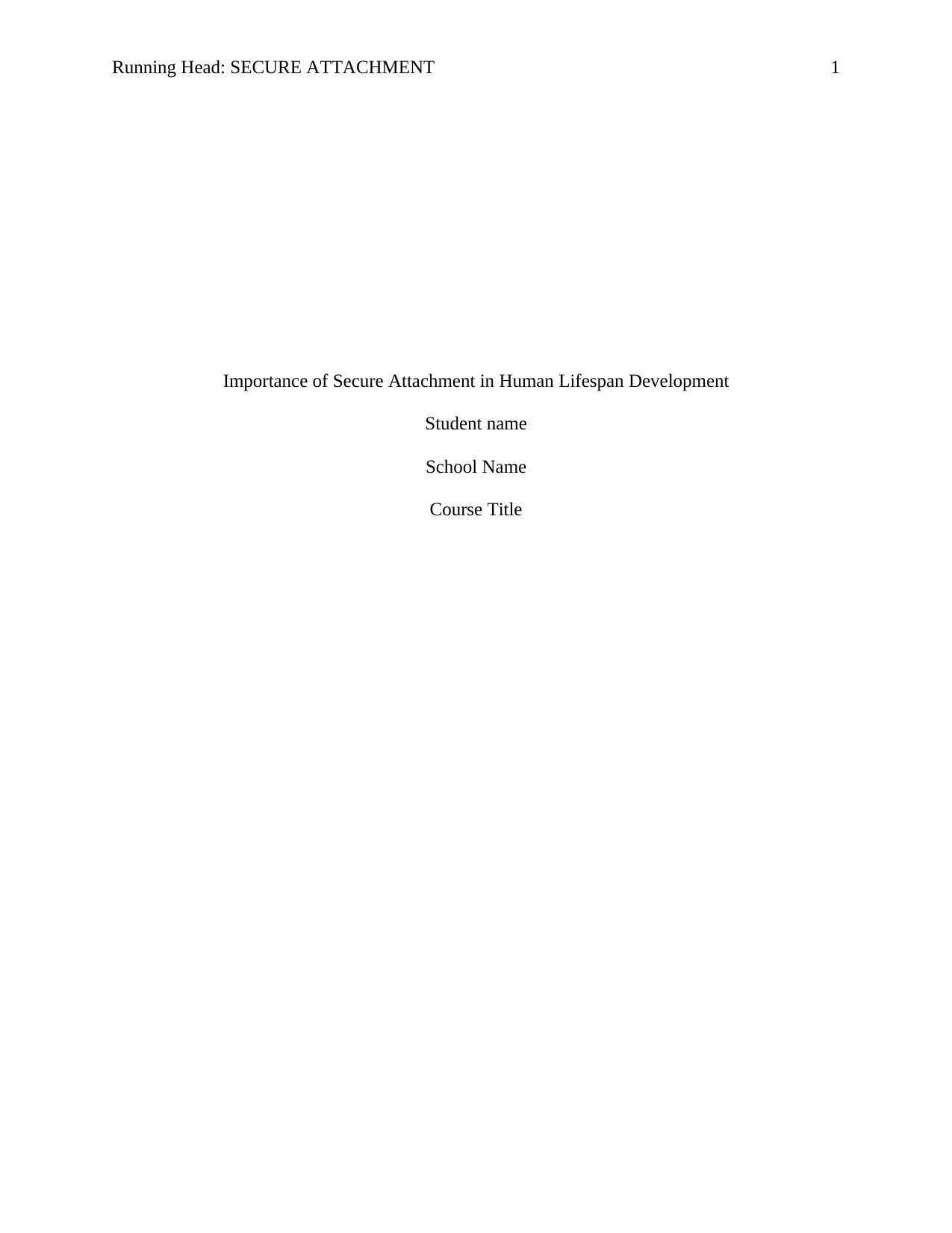
Running Head: SECURE ATTACHMENT 1
Importance of Secure Attachment in Human Lifespan Development
Student name
School Name
Course Title
Importance of Secure Attachment in Human Lifespan Development
Student name
School Name
Course Title
Paraphrase This Document
Need a fresh take? Get an instant paraphrase of this document with our AI Paraphraser
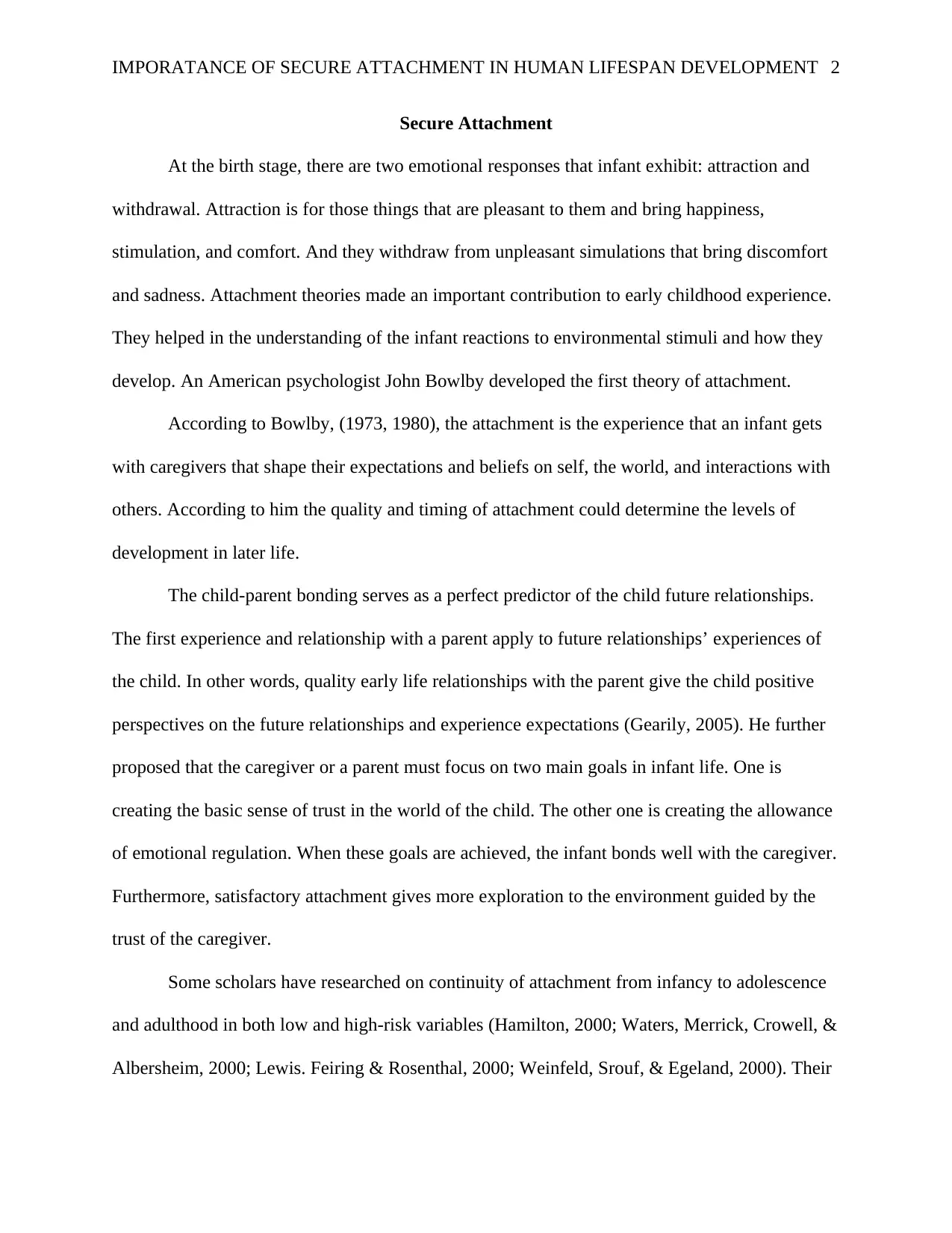
IMPORATANCE OF SECURE ATTACHMENT IN HUMAN LIFESPAN DEVELOPMENT 2
Secure Attachment
At the birth stage, there are two emotional responses that infant exhibit: attraction and
withdrawal. Attraction is for those things that are pleasant to them and bring happiness,
stimulation, and comfort. And they withdraw from unpleasant simulations that bring discomfort
and sadness. Attachment theories made an important contribution to early childhood experience.
They helped in the understanding of the infant reactions to environmental stimuli and how they
develop. An American psychologist John Bowlby developed the first theory of attachment.
According to Bowlby, (1973, 1980), the attachment is the experience that an infant gets
with caregivers that shape their expectations and beliefs on self, the world, and interactions with
others. According to him the quality and timing of attachment could determine the levels of
development in later life.
The child-parent bonding serves as a perfect predictor of the child future relationships.
The first experience and relationship with a parent apply to future relationships’ experiences of
the child. In other words, quality early life relationships with the parent give the child positive
perspectives on the future relationships and experience expectations (Gearily, 2005). He further
proposed that the caregiver or a parent must focus on two main goals in infant life. One is
creating the basic sense of trust in the world of the child. The other one is creating the allowance
of emotional regulation. When these goals are achieved, the infant bonds well with the caregiver.
Furthermore, satisfactory attachment gives more exploration to the environment guided by the
trust of the caregiver.
Some scholars have researched on continuity of attachment from infancy to adolescence
and adulthood in both low and high-risk variables (Hamilton, 2000; Waters, Merrick, Crowell, &
Albersheim, 2000; Lewis. Feiring & Rosenthal, 2000; Weinfeld, Srouf, & Egeland, 2000). Their
Secure Attachment
At the birth stage, there are two emotional responses that infant exhibit: attraction and
withdrawal. Attraction is for those things that are pleasant to them and bring happiness,
stimulation, and comfort. And they withdraw from unpleasant simulations that bring discomfort
and sadness. Attachment theories made an important contribution to early childhood experience.
They helped in the understanding of the infant reactions to environmental stimuli and how they
develop. An American psychologist John Bowlby developed the first theory of attachment.
According to Bowlby, (1973, 1980), the attachment is the experience that an infant gets
with caregivers that shape their expectations and beliefs on self, the world, and interactions with
others. According to him the quality and timing of attachment could determine the levels of
development in later life.
The child-parent bonding serves as a perfect predictor of the child future relationships.
The first experience and relationship with a parent apply to future relationships’ experiences of
the child. In other words, quality early life relationships with the parent give the child positive
perspectives on the future relationships and experience expectations (Gearily, 2005). He further
proposed that the caregiver or a parent must focus on two main goals in infant life. One is
creating the basic sense of trust in the world of the child. The other one is creating the allowance
of emotional regulation. When these goals are achieved, the infant bonds well with the caregiver.
Furthermore, satisfactory attachment gives more exploration to the environment guided by the
trust of the caregiver.
Some scholars have researched on continuity of attachment from infancy to adolescence
and adulthood in both low and high-risk variables (Hamilton, 2000; Waters, Merrick, Crowell, &
Albersheim, 2000; Lewis. Feiring & Rosenthal, 2000; Weinfeld, Srouf, & Egeland, 2000). Their
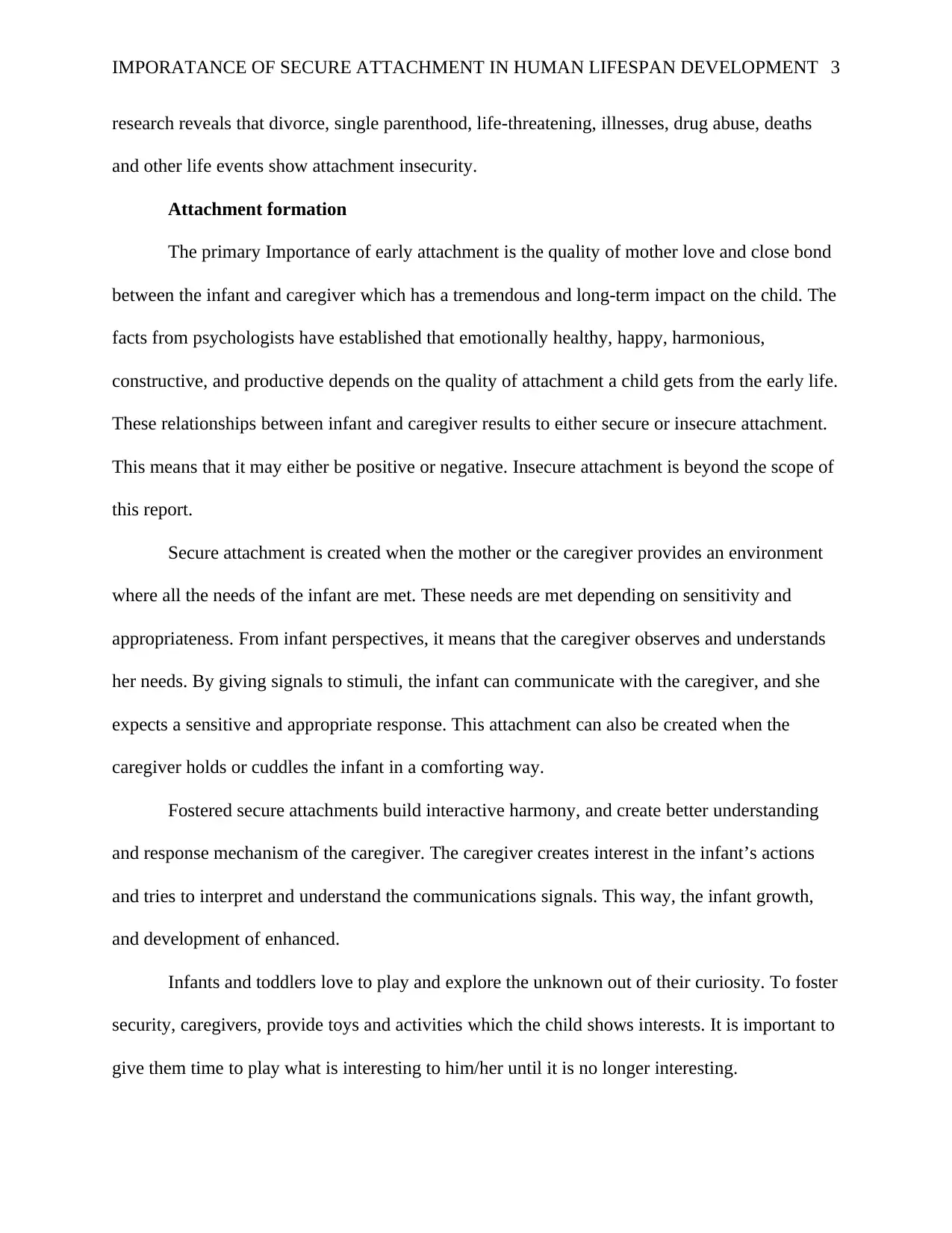
IMPORATANCE OF SECURE ATTACHMENT IN HUMAN LIFESPAN DEVELOPMENT 3
research reveals that divorce, single parenthood, life-threatening, illnesses, drug abuse, deaths
and other life events show attachment insecurity.
Attachment formation
The primary Importance of early attachment is the quality of mother love and close bond
between the infant and caregiver which has a tremendous and long-term impact on the child. The
facts from psychologists have established that emotionally healthy, happy, harmonious,
constructive, and productive depends on the quality of attachment a child gets from the early life.
These relationships between infant and caregiver results to either secure or insecure attachment.
This means that it may either be positive or negative. Insecure attachment is beyond the scope of
this report.
Secure attachment is created when the mother or the caregiver provides an environment
where all the needs of the infant are met. These needs are met depending on sensitivity and
appropriateness. From infant perspectives, it means that the caregiver observes and understands
her needs. By giving signals to stimuli, the infant can communicate with the caregiver, and she
expects a sensitive and appropriate response. This attachment can also be created when the
caregiver holds or cuddles the infant in a comforting way.
Fostered secure attachments build interactive harmony, and create better understanding
and response mechanism of the caregiver. The caregiver creates interest in the infant’s actions
and tries to interpret and understand the communications signals. This way, the infant growth,
and development of enhanced.
Infants and toddlers love to play and explore the unknown out of their curiosity. To foster
security, caregivers, provide toys and activities which the child shows interests. It is important to
give them time to play what is interesting to him/her until it is no longer interesting.
research reveals that divorce, single parenthood, life-threatening, illnesses, drug abuse, deaths
and other life events show attachment insecurity.
Attachment formation
The primary Importance of early attachment is the quality of mother love and close bond
between the infant and caregiver which has a tremendous and long-term impact on the child. The
facts from psychologists have established that emotionally healthy, happy, harmonious,
constructive, and productive depends on the quality of attachment a child gets from the early life.
These relationships between infant and caregiver results to either secure or insecure attachment.
This means that it may either be positive or negative. Insecure attachment is beyond the scope of
this report.
Secure attachment is created when the mother or the caregiver provides an environment
where all the needs of the infant are met. These needs are met depending on sensitivity and
appropriateness. From infant perspectives, it means that the caregiver observes and understands
her needs. By giving signals to stimuli, the infant can communicate with the caregiver, and she
expects a sensitive and appropriate response. This attachment can also be created when the
caregiver holds or cuddles the infant in a comforting way.
Fostered secure attachments build interactive harmony, and create better understanding
and response mechanism of the caregiver. The caregiver creates interest in the infant’s actions
and tries to interpret and understand the communications signals. This way, the infant growth,
and development of enhanced.
Infants and toddlers love to play and explore the unknown out of their curiosity. To foster
security, caregivers, provide toys and activities which the child shows interests. It is important to
give them time to play what is interesting to him/her until it is no longer interesting.
⊘ This is a preview!⊘
Do you want full access?
Subscribe today to unlock all pages.

Trusted by 1+ million students worldwide
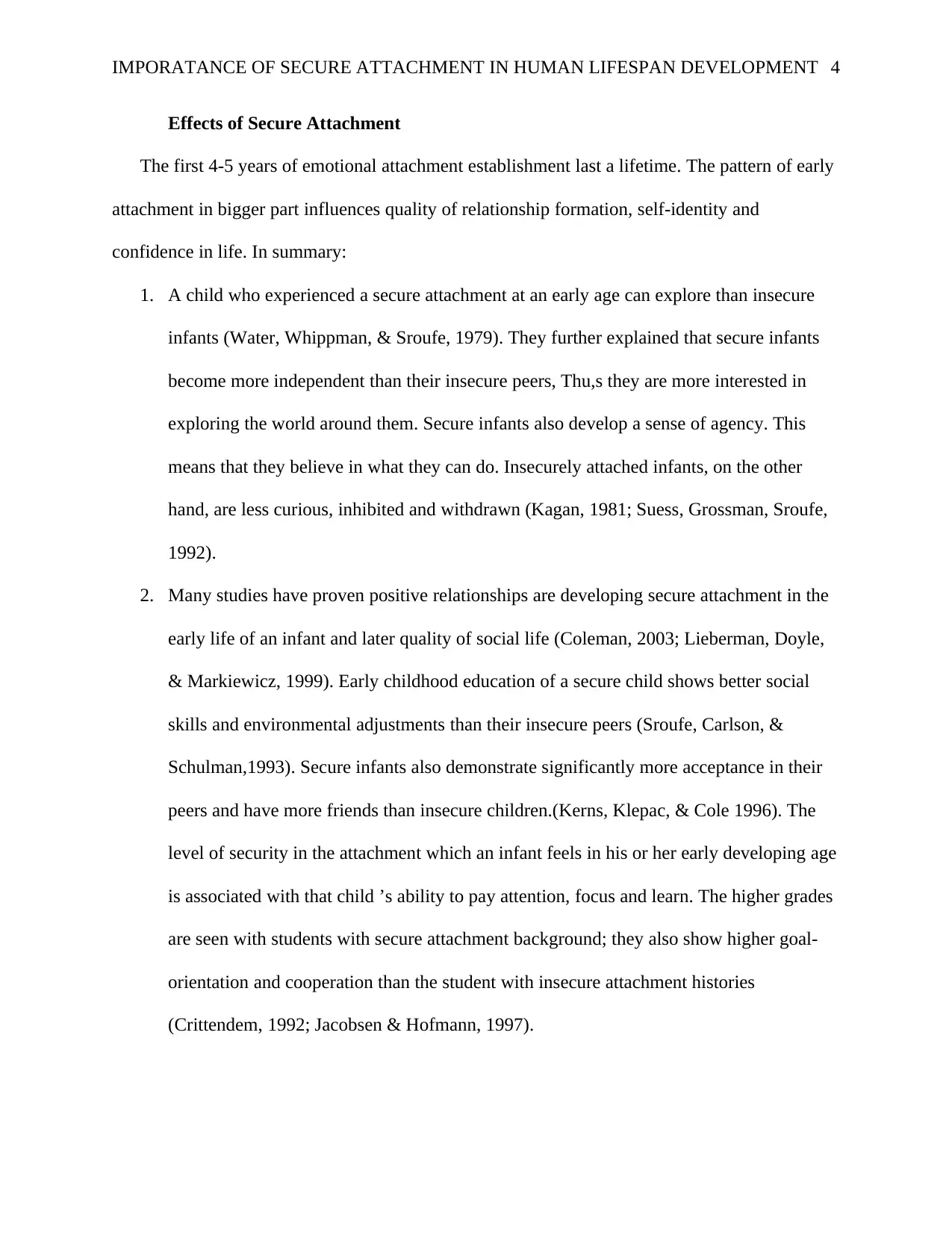
IMPORATANCE OF SECURE ATTACHMENT IN HUMAN LIFESPAN DEVELOPMENT 4
Effects of Secure Attachment
The first 4-5 years of emotional attachment establishment last a lifetime. The pattern of early
attachment in bigger part influences quality of relationship formation, self-identity and
confidence in life. In summary:
1. A child who experienced a secure attachment at an early age can explore than insecure
infants (Water, Whippman, & Sroufe, 1979). They further explained that secure infants
become more independent than their insecure peers, Thu,s they are more interested in
exploring the world around them. Secure infants also develop a sense of agency. This
means that they believe in what they can do. Insecurely attached infants, on the other
hand, are less curious, inhibited and withdrawn (Kagan, 1981; Suess, Grossman, Sroufe,
1992).
2. Many studies have proven positive relationships are developing secure attachment in the
early life of an infant and later quality of social life (Coleman, 2003; Lieberman, Doyle,
& Markiewicz, 1999). Early childhood education of a secure child shows better social
skills and environmental adjustments than their insecure peers (Sroufe, Carlson, &
Schulman,1993). Secure infants also demonstrate significantly more acceptance in their
peers and have more friends than insecure children.(Kerns, Klepac, & Cole 1996). The
level of security in the attachment which an infant feels in his or her early developing age
is associated with that child ’s ability to pay attention, focus and learn. The higher grades
are seen with students with secure attachment background; they also show higher goal-
orientation and cooperation than the student with insecure attachment histories
(Crittendem, 1992; Jacobsen & Hofmann, 1997).
Effects of Secure Attachment
The first 4-5 years of emotional attachment establishment last a lifetime. The pattern of early
attachment in bigger part influences quality of relationship formation, self-identity and
confidence in life. In summary:
1. A child who experienced a secure attachment at an early age can explore than insecure
infants (Water, Whippman, & Sroufe, 1979). They further explained that secure infants
become more independent than their insecure peers, Thu,s they are more interested in
exploring the world around them. Secure infants also develop a sense of agency. This
means that they believe in what they can do. Insecurely attached infants, on the other
hand, are less curious, inhibited and withdrawn (Kagan, 1981; Suess, Grossman, Sroufe,
1992).
2. Many studies have proven positive relationships are developing secure attachment in the
early life of an infant and later quality of social life (Coleman, 2003; Lieberman, Doyle,
& Markiewicz, 1999). Early childhood education of a secure child shows better social
skills and environmental adjustments than their insecure peers (Sroufe, Carlson, &
Schulman,1993). Secure infants also demonstrate significantly more acceptance in their
peers and have more friends than insecure children.(Kerns, Klepac, & Cole 1996). The
level of security in the attachment which an infant feels in his or her early developing age
is associated with that child ’s ability to pay attention, focus and learn. The higher grades
are seen with students with secure attachment background; they also show higher goal-
orientation and cooperation than the student with insecure attachment histories
(Crittendem, 1992; Jacobsen & Hofmann, 1997).
Paraphrase This Document
Need a fresh take? Get an instant paraphrase of this document with our AI Paraphraser
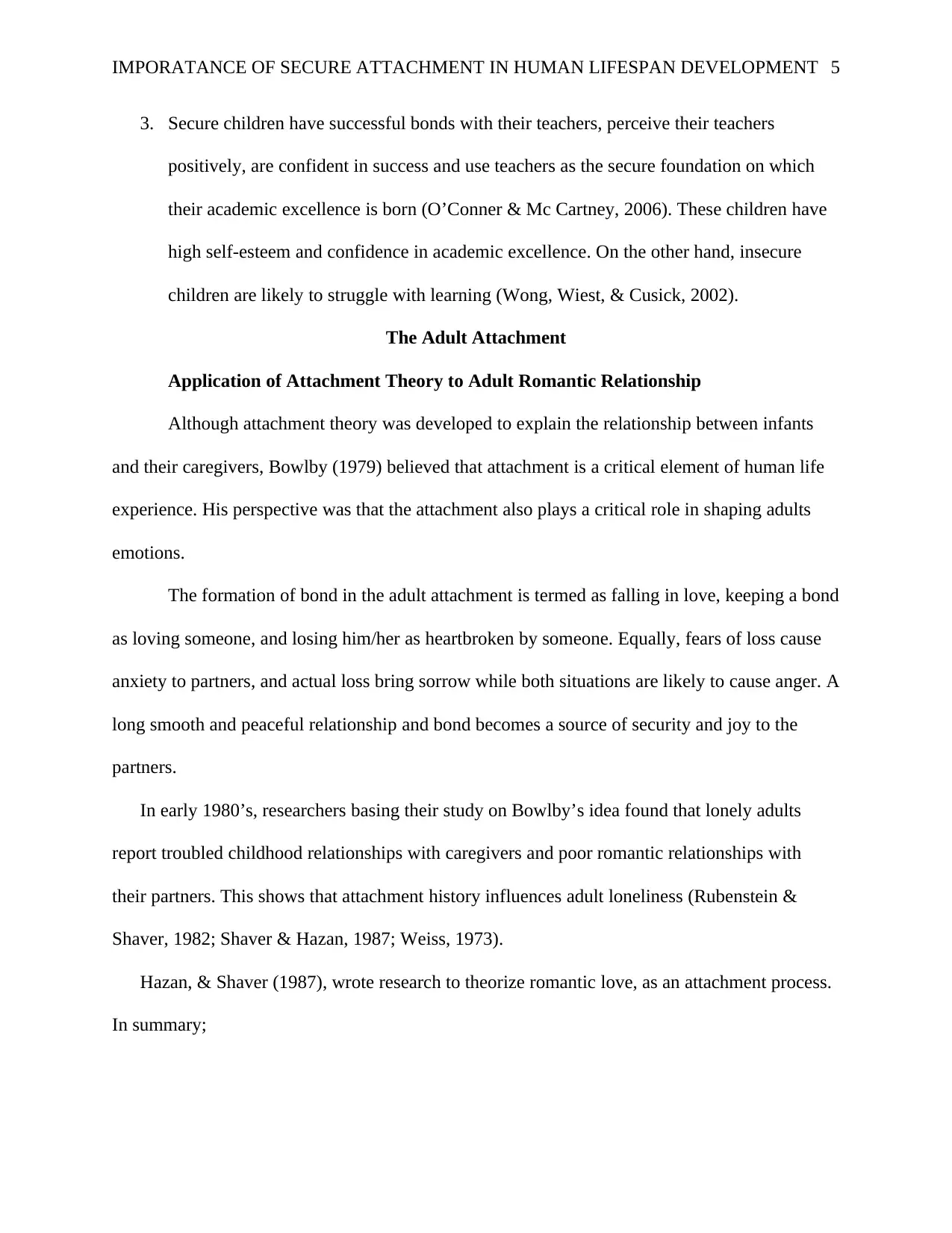
IMPORATANCE OF SECURE ATTACHMENT IN HUMAN LIFESPAN DEVELOPMENT 5
3. Secure children have successful bonds with their teachers, perceive their teachers
positively, are confident in success and use teachers as the secure foundation on which
their academic excellence is born (O’Conner & Mc Cartney, 2006). These children have
high self-esteem and confidence in academic excellence. On the other hand, insecure
children are likely to struggle with learning (Wong, Wiest, & Cusick, 2002).
The Adult Attachment
Application of Attachment Theory to Adult Romantic Relationship
Although attachment theory was developed to explain the relationship between infants
and their caregivers, Bowlby (1979) believed that attachment is a critical element of human life
experience. His perspective was that the attachment also plays a critical role in shaping adults
emotions.
The formation of bond in the adult attachment is termed as falling in love, keeping a bond
as loving someone, and losing him/her as heartbroken by someone. Equally, fears of loss cause
anxiety to partners, and actual loss bring sorrow while both situations are likely to cause anger. A
long smooth and peaceful relationship and bond becomes a source of security and joy to the
partners.
In early 1980’s, researchers basing their study on Bowlby’s idea found that lonely adults
report troubled childhood relationships with caregivers and poor romantic relationships with
their partners. This shows that attachment history influences adult loneliness (Rubenstein &
Shaver, 1982; Shaver & Hazan, 1987; Weiss, 1973).
Hazan, & Shaver (1987), wrote research to theorize romantic love, as an attachment process.
In summary;
3. Secure children have successful bonds with their teachers, perceive their teachers
positively, are confident in success and use teachers as the secure foundation on which
their academic excellence is born (O’Conner & Mc Cartney, 2006). These children have
high self-esteem and confidence in academic excellence. On the other hand, insecure
children are likely to struggle with learning (Wong, Wiest, & Cusick, 2002).
The Adult Attachment
Application of Attachment Theory to Adult Romantic Relationship
Although attachment theory was developed to explain the relationship between infants
and their caregivers, Bowlby (1979) believed that attachment is a critical element of human life
experience. His perspective was that the attachment also plays a critical role in shaping adults
emotions.
The formation of bond in the adult attachment is termed as falling in love, keeping a bond
as loving someone, and losing him/her as heartbroken by someone. Equally, fears of loss cause
anxiety to partners, and actual loss bring sorrow while both situations are likely to cause anger. A
long smooth and peaceful relationship and bond becomes a source of security and joy to the
partners.
In early 1980’s, researchers basing their study on Bowlby’s idea found that lonely adults
report troubled childhood relationships with caregivers and poor romantic relationships with
their partners. This shows that attachment history influences adult loneliness (Rubenstein &
Shaver, 1982; Shaver & Hazan, 1987; Weiss, 1973).
Hazan, & Shaver (1987), wrote research to theorize romantic love, as an attachment process.
In summary;
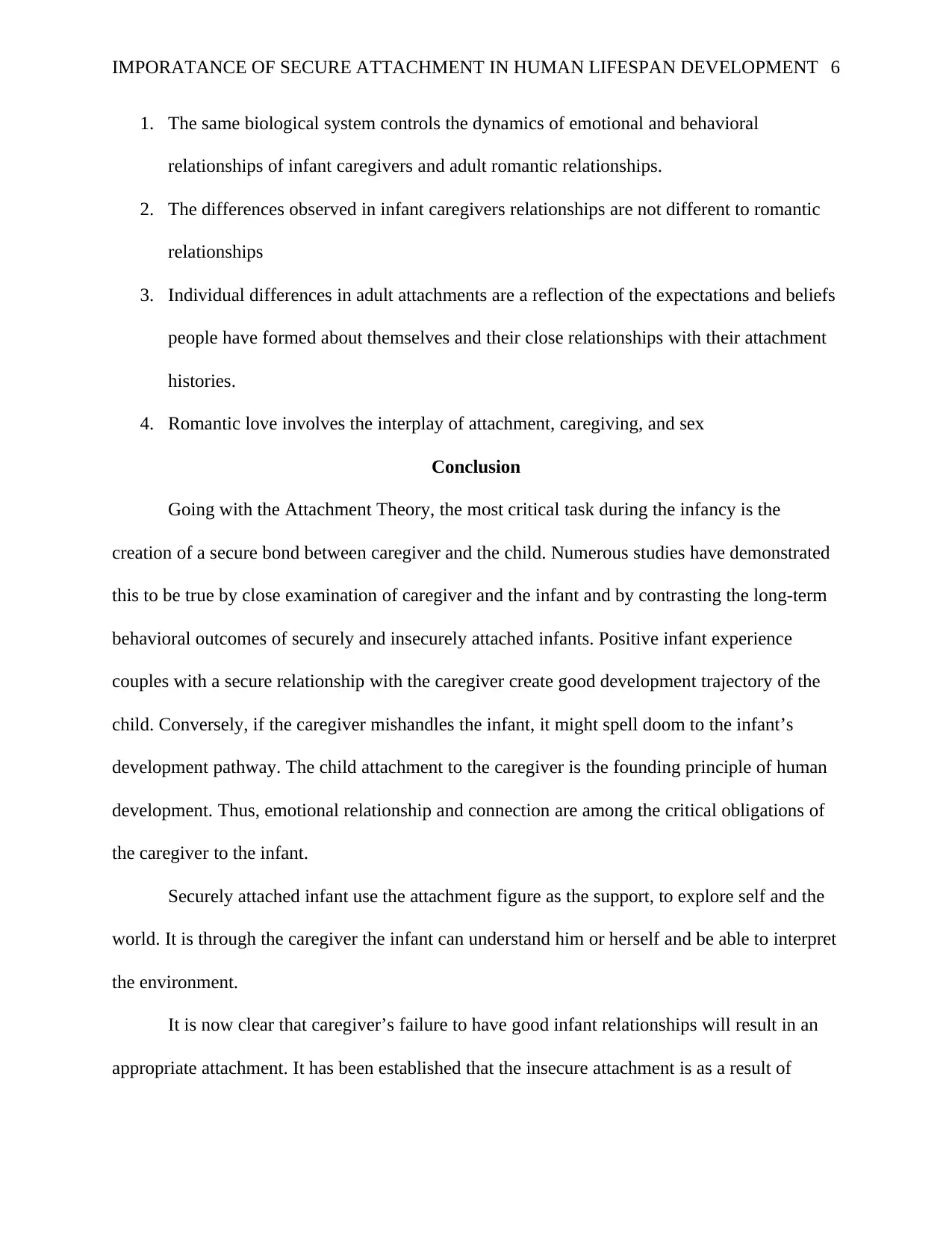
IMPORATANCE OF SECURE ATTACHMENT IN HUMAN LIFESPAN DEVELOPMENT 6
1. The same biological system controls the dynamics of emotional and behavioral
relationships of infant caregivers and adult romantic relationships.
2. The differences observed in infant caregivers relationships are not different to romantic
relationships
3. Individual differences in adult attachments are a reflection of the expectations and beliefs
people have formed about themselves and their close relationships with their attachment
histories.
4. Romantic love involves the interplay of attachment, caregiving, and sex
Conclusion
Going with the Attachment Theory, the most critical task during the infancy is the
creation of a secure bond between caregiver and the child. Numerous studies have demonstrated
this to be true by close examination of caregiver and the infant and by contrasting the long-term
behavioral outcomes of securely and insecurely attached infants. Positive infant experience
couples with a secure relationship with the caregiver create good development trajectory of the
child. Conversely, if the caregiver mishandles the infant, it might spell doom to the infant’s
development pathway. The child attachment to the caregiver is the founding principle of human
development. Thus, emotional relationship and connection are among the critical obligations of
the caregiver to the infant.
Securely attached infant use the attachment figure as the support, to explore self and the
world. It is through the caregiver the infant can understand him or herself and be able to interpret
the environment.
It is now clear that caregiver’s failure to have good infant relationships will result in an
appropriate attachment. It has been established that the insecure attachment is as a result of
1. The same biological system controls the dynamics of emotional and behavioral
relationships of infant caregivers and adult romantic relationships.
2. The differences observed in infant caregivers relationships are not different to romantic
relationships
3. Individual differences in adult attachments are a reflection of the expectations and beliefs
people have formed about themselves and their close relationships with their attachment
histories.
4. Romantic love involves the interplay of attachment, caregiving, and sex
Conclusion
Going with the Attachment Theory, the most critical task during the infancy is the
creation of a secure bond between caregiver and the child. Numerous studies have demonstrated
this to be true by close examination of caregiver and the infant and by contrasting the long-term
behavioral outcomes of securely and insecurely attached infants. Positive infant experience
couples with a secure relationship with the caregiver create good development trajectory of the
child. Conversely, if the caregiver mishandles the infant, it might spell doom to the infant’s
development pathway. The child attachment to the caregiver is the founding principle of human
development. Thus, emotional relationship and connection are among the critical obligations of
the caregiver to the infant.
Securely attached infant use the attachment figure as the support, to explore self and the
world. It is through the caregiver the infant can understand him or herself and be able to interpret
the environment.
It is now clear that caregiver’s failure to have good infant relationships will result in an
appropriate attachment. It has been established that the insecure attachment is as a result of
⊘ This is a preview!⊘
Do you want full access?
Subscribe today to unlock all pages.

Trusted by 1+ million students worldwide
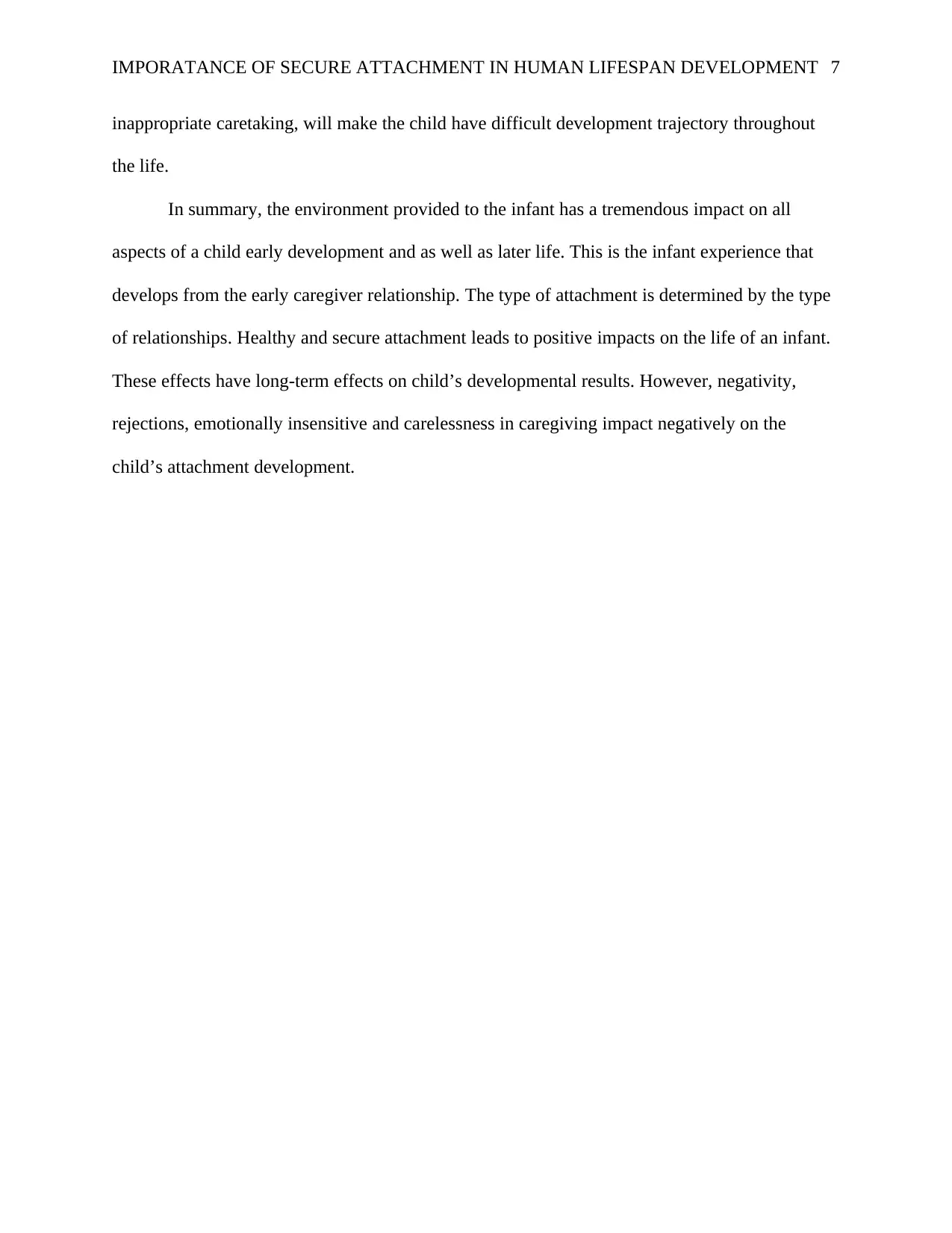
IMPORATANCE OF SECURE ATTACHMENT IN HUMAN LIFESPAN DEVELOPMENT 7
inappropriate caretaking, will make the child have difficult development trajectory throughout
the life.
In summary, the environment provided to the infant has a tremendous impact on all
aspects of a child early development and as well as later life. This is the infant experience that
develops from the early caregiver relationship. The type of attachment is determined by the type
of relationships. Healthy and secure attachment leads to positive impacts on the life of an infant.
These effects have long-term effects on child’s developmental results. However, negativity,
rejections, emotionally insensitive and carelessness in caregiving impact negatively on the
child’s attachment development.
inappropriate caretaking, will make the child have difficult development trajectory throughout
the life.
In summary, the environment provided to the infant has a tremendous impact on all
aspects of a child early development and as well as later life. This is the infant experience that
develops from the early caregiver relationship. The type of attachment is determined by the type
of relationships. Healthy and secure attachment leads to positive impacts on the life of an infant.
These effects have long-term effects on child’s developmental results. However, negativity,
rejections, emotionally insensitive and carelessness in caregiving impact negatively on the
child’s attachment development.
Paraphrase This Document
Need a fresh take? Get an instant paraphrase of this document with our AI Paraphraser
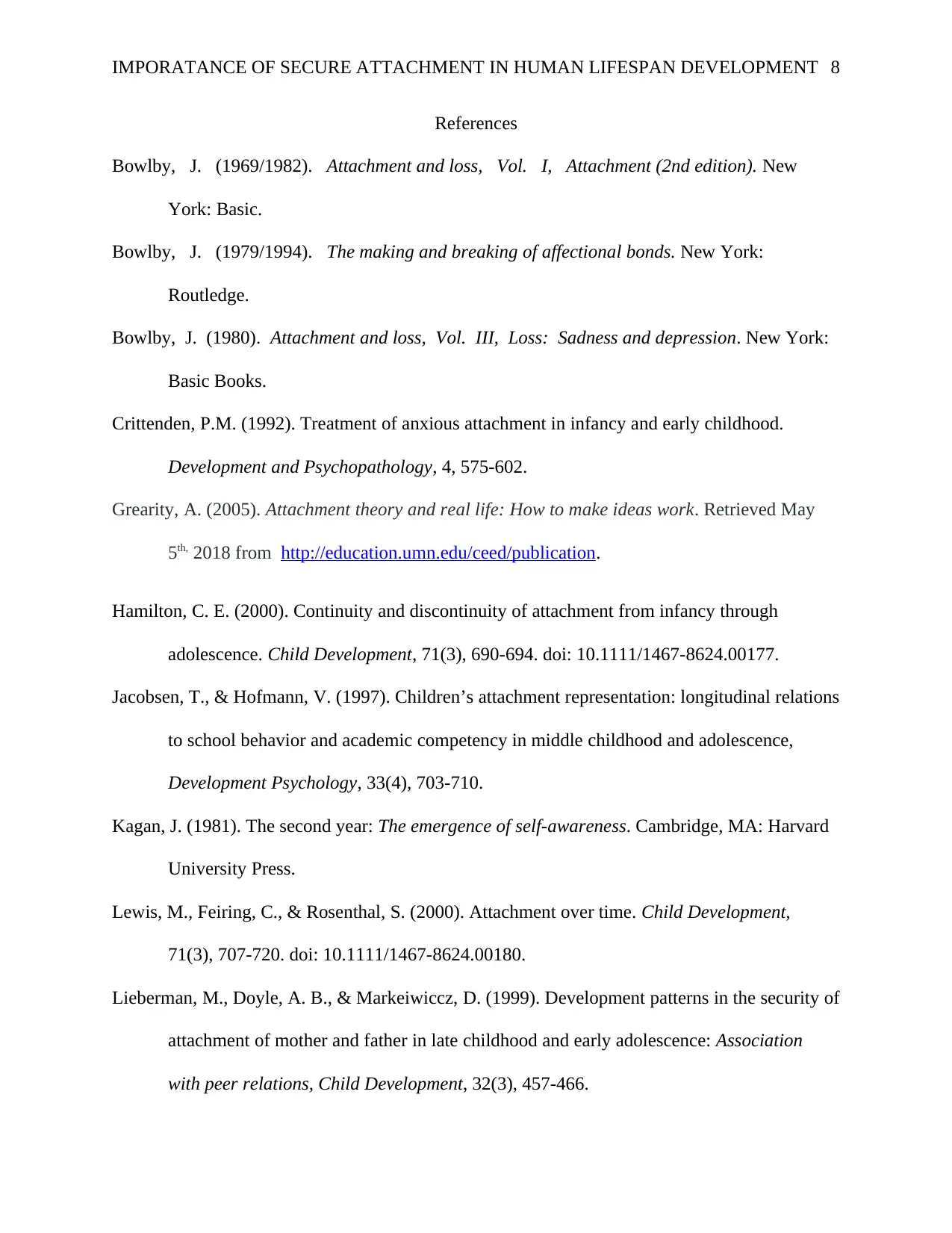
IMPORATANCE OF SECURE ATTACHMENT IN HUMAN LIFESPAN DEVELOPMENT 8
References
Bowlby, J. (1969/1982). Attachment and loss, Vol. I, Attachment (2nd edition). New
York: Basic.
Bowlby, J. (1979/1994). The making and breaking of affectional bonds. New York:
Routledge.
Bowlby, J. (1980). Attachment and loss, Vol. III, Loss: Sadness and depression. New York:
Basic Books.
Crittenden, P.M. (1992). Treatment of anxious attachment in infancy and early childhood.
Development and Psychopathology, 4, 575-602.
Grearity, A. (2005). Attachment theory and real life: How to make ideas work. Retrieved May
5th, 2018 from http://education.umn.edu/ceed/publication.
Hamilton, C. E. (2000). Continuity and discontinuity of attachment from infancy through
adolescence. Child Development, 71(3), 690-694. doi: 10.1111/1467-8624.00177.
Jacobsen, T., & Hofmann, V. (1997). Children’s attachment representation: longitudinal relations
to school behavior and academic competency in middle childhood and adolescence,
Development Psychology, 33(4), 703-710.
Kagan, J. (1981). The second year: The emergence of self-awareness. Cambridge, MA: Harvard
University Press.
Lewis, M., Feiring, C., & Rosenthal, S. (2000). Attachment over time. Child Development,
71(3), 707-720. doi: 10.1111/1467-8624.00180.
Lieberman, M., Doyle, A. B., & Markeiwiccz, D. (1999). Development patterns in the security of
attachment of mother and father in late childhood and early adolescence: Association
with peer relations, Child Development, 32(3), 457-466.
References
Bowlby, J. (1969/1982). Attachment and loss, Vol. I, Attachment (2nd edition). New
York: Basic.
Bowlby, J. (1979/1994). The making and breaking of affectional bonds. New York:
Routledge.
Bowlby, J. (1980). Attachment and loss, Vol. III, Loss: Sadness and depression. New York:
Basic Books.
Crittenden, P.M. (1992). Treatment of anxious attachment in infancy and early childhood.
Development and Psychopathology, 4, 575-602.
Grearity, A. (2005). Attachment theory and real life: How to make ideas work. Retrieved May
5th, 2018 from http://education.umn.edu/ceed/publication.
Hamilton, C. E. (2000). Continuity and discontinuity of attachment from infancy through
adolescence. Child Development, 71(3), 690-694. doi: 10.1111/1467-8624.00177.
Jacobsen, T., & Hofmann, V. (1997). Children’s attachment representation: longitudinal relations
to school behavior and academic competency in middle childhood and adolescence,
Development Psychology, 33(4), 703-710.
Kagan, J. (1981). The second year: The emergence of self-awareness. Cambridge, MA: Harvard
University Press.
Lewis, M., Feiring, C., & Rosenthal, S. (2000). Attachment over time. Child Development,
71(3), 707-720. doi: 10.1111/1467-8624.00180.
Lieberman, M., Doyle, A. B., & Markeiwiccz, D. (1999). Development patterns in the security of
attachment of mother and father in late childhood and early adolescence: Association
with peer relations, Child Development, 32(3), 457-466.
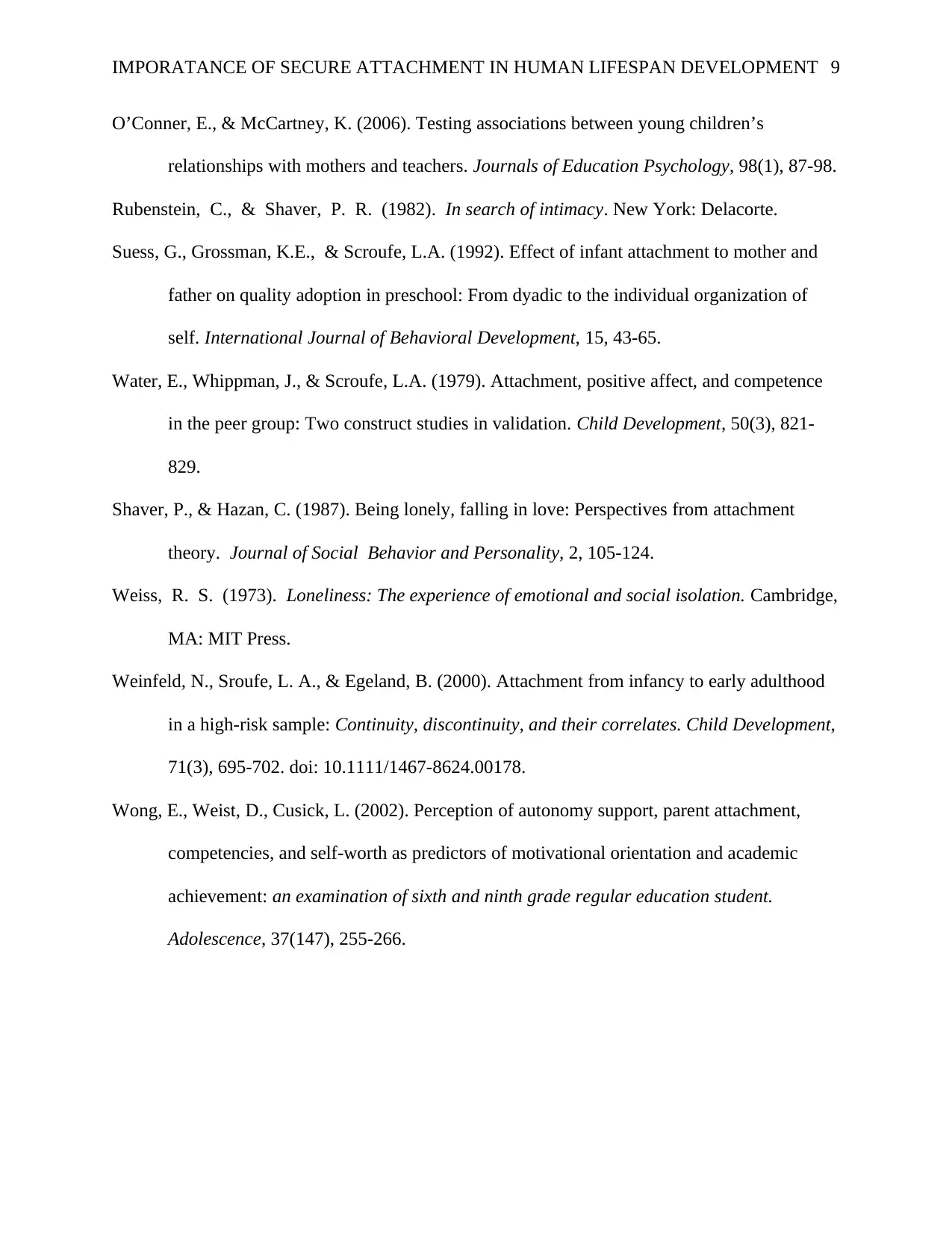
IMPORATANCE OF SECURE ATTACHMENT IN HUMAN LIFESPAN DEVELOPMENT 9
O’Conner, E., & McCartney, K. (2006). Testing associations between young children’s
relationships with mothers and teachers. Journals of Education Psychology, 98(1), 87-98.
Rubenstein, C., & Shaver, P. R. (1982). In search of intimacy. New York: Delacorte.
Suess, G., Grossman, K.E., & Scroufe, L.A. (1992). Effect of infant attachment to mother and
father on quality adoption in preschool: From dyadic to the individual organization of
self. International Journal of Behavioral Development, 15, 43-65.
Water, E., Whippman, J., & Scroufe, L.A. (1979). Attachment, positive affect, and competence
in the peer group: Two construct studies in validation. Child Development, 50(3), 821-
829.
Shaver, P., & Hazan, C. (1987). Being lonely, falling in love: Perspectives from attachment
theory. Journal of Social Behavior and Personality, 2, 105-124.
Weiss, R. S. (1973). Loneliness: The experience of emotional and social isolation. Cambridge,
MA: MIT Press.
Weinfeld, N., Sroufe, L. A., & Egeland, B. (2000). Attachment from infancy to early adulthood
in a high-risk sample: Continuity, discontinuity, and their correlates. Child Development,
71(3), 695-702. doi: 10.1111/1467-8624.00178.
Wong, E., Weist, D., Cusick, L. (2002). Perception of autonomy support, parent attachment,
competencies, and self-worth as predictors of motivational orientation and academic
achievement: an examination of sixth and ninth grade regular education student.
Adolescence, 37(147), 255-266.
O’Conner, E., & McCartney, K. (2006). Testing associations between young children’s
relationships with mothers and teachers. Journals of Education Psychology, 98(1), 87-98.
Rubenstein, C., & Shaver, P. R. (1982). In search of intimacy. New York: Delacorte.
Suess, G., Grossman, K.E., & Scroufe, L.A. (1992). Effect of infant attachment to mother and
father on quality adoption in preschool: From dyadic to the individual organization of
self. International Journal of Behavioral Development, 15, 43-65.
Water, E., Whippman, J., & Scroufe, L.A. (1979). Attachment, positive affect, and competence
in the peer group: Two construct studies in validation. Child Development, 50(3), 821-
829.
Shaver, P., & Hazan, C. (1987). Being lonely, falling in love: Perspectives from attachment
theory. Journal of Social Behavior and Personality, 2, 105-124.
Weiss, R. S. (1973). Loneliness: The experience of emotional and social isolation. Cambridge,
MA: MIT Press.
Weinfeld, N., Sroufe, L. A., & Egeland, B. (2000). Attachment from infancy to early adulthood
in a high-risk sample: Continuity, discontinuity, and their correlates. Child Development,
71(3), 695-702. doi: 10.1111/1467-8624.00178.
Wong, E., Weist, D., Cusick, L. (2002). Perception of autonomy support, parent attachment,
competencies, and self-worth as predictors of motivational orientation and academic
achievement: an examination of sixth and ninth grade regular education student.
Adolescence, 37(147), 255-266.
⊘ This is a preview!⊘
Do you want full access?
Subscribe today to unlock all pages.

Trusted by 1+ million students worldwide
1 out of 9
Related Documents
Your All-in-One AI-Powered Toolkit for Academic Success.
+13062052269
info@desklib.com
Available 24*7 on WhatsApp / Email
![[object Object]](/_next/static/media/star-bottom.7253800d.svg)
Unlock your academic potential
Copyright © 2020–2025 A2Z Services. All Rights Reserved. Developed and managed by ZUCOL.





